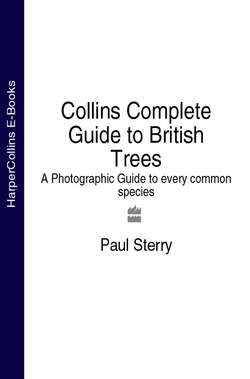Читать книгу Collins Complete Guide to British Trees: A Photographic Guide to every common species - Paul Sterry - Страница 22
MANAGED PEDUNCULATE OAK STANDARDS WITH HAZEL COPPICE
ОглавлениеThe Pedunculate Oak is one of the most common large native tree species across much of central and southern England, and in many woodlands it dominates in terms of stature and tree canopy cover. In some areas, its prevalence may be the result of soil conditions favouring its growth over other species. However, in many instances, an examination of the woodland structure and history will reveal man’s contribution to the equation. If, for example, a particular woodland has oaks all of a similar size, then even if they are old their presence and dominance is likely to be the result of planting, in earlier centuries, and of selective felling of other species. This is hardly surprising because oak has always been considered the construction timber of choice. In such circumstances, mature oaks are referred to as standards.
In many semi-natural Pedunculate Oak woodlands you will find an understorey of Hazel. Typically this species will have been planted and managed on a regular basis by coppicing (see p.) to produce a constant supply of straight branches, used in hurdle-making and other woodland crafts.
A managed Pedunculate Oak woodland has near-continuous canopy cover. Only in winter and spring, before the leaves emerge, do significant light levels penetrate to the woodland floor.
In spring, a sympathetically managed woodland of this type is a floral delight to the eye, with carpets of Bluebells, Wood Anemones and Wood-sorrel intermingling with patches of Dog’s Mercury, Early-purple Orchids and Wild Daffodils. Pedunculate Oaks probably support the greatest diversity of invertebrate life of any of our trees, feeding beetles and moth larvae in abundance. If the occasional Sallow also grows among them, then there is a good chance that Purple Emperor butterflies may be present, assuming the woodland lies within this species’ restricted English range. The larvae feed on Sallow leaves but the adults – males in particular – depend on mature oak standards, using their canopies to define and defend territories. Birdlife is usually as rich as can be expected for a lowland woodland but arguably the star of the show is the Dormouse. Dependent on Hazel nuts in autumn, they occupy the oak canopy for much of spring and summer, feeding on oak flowers and insects.
A majestic male Purple Emperor surveys his domain from the canopy of a mature Pedunculate Oak.
Carpets of Bluebells are a stunning feature of managed Pedunculate Oak woodland in lowland Britain.
